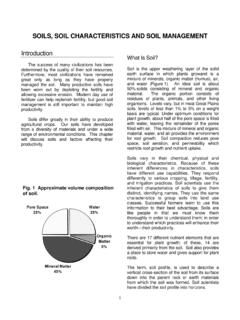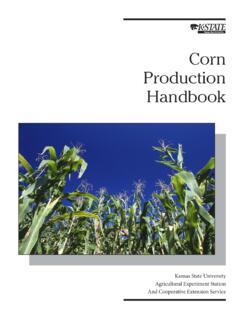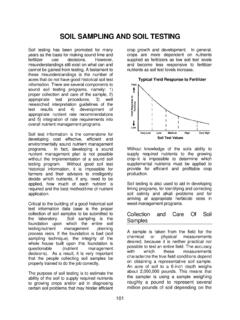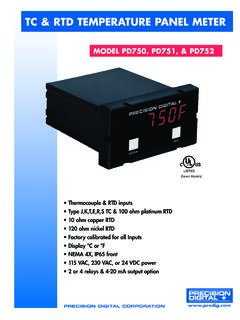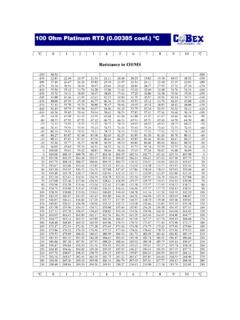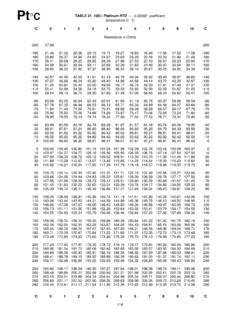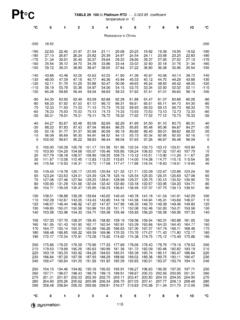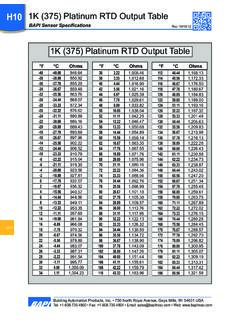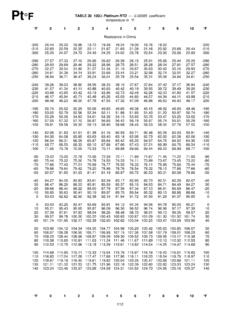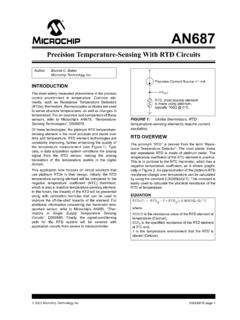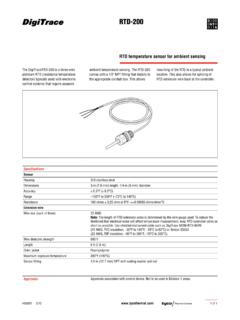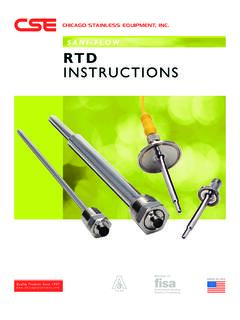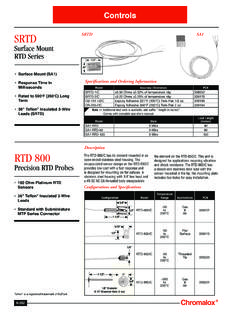Transcription of RTD (Resistance Temperature Detector)
1 Temperature AGRON 901: Page 1 RTD ( resistance Temperature Detector) Highlighted Sensor: 100 ohm PRT, DIN 43760, = , ( , Omega TFD or 1PT100FR828) General Principles of Operation and Theory A resistance Temperature Detector (RTD) is a type of sensor element that has a Temperature -dependent electrical resistance . The resistance of a RTD increases with Temperature in a linear manner over the terrestrial Temperature range ( , -50 to 100C). RTDs are made from metals or mixtures of metals, with platinum being the most common.
2 platinum RTDs are often called PRTs ( platinum resistance Thermometers). RTD: resistance vs. TemperatureRo=100 ohms, = ohm/ohm-C8090100110120130140150-20020406 080100120 Temperature (C) resistance (ohms) RTDs can be purchased in many shapes and sizes, but in general are not a small as thermistors. Omega Engineering (Stamford, Connecticut) sells a wide array of RTDs well suited for air and soil Temperature measurements (see attachment). For example the 1PT100FR828 (8 mm long, mm diam.) is good choice for putting inside a soil probe or water bath, while the very small TFD sensor ( x x mm) is great for air Temperature sensing.
3 RTD specifications include: 1. Sensor material ( , platinum , nickel-iron) 2. Temperature coefficient (TC), or alpha value ( ) ( , ohm/ohm-C) 3. Reference resistance , Ro ( resistance an 0 C) 4. Wiring configuration, optional ( , 3-wire bridge) The most common RTDs are made of platinum , have a reference resistance of 100 ohms at 0 C, and have a Temperature coefficient of resistance , , of ohm/ohm-C. The alpha value is a property of the metal or alloy used to make the RTD element and describes the average resistance change per unit Temperature from the ice point to 100 C.
4 A probe with an Ro of 100 ohms and = will have a resistance of 100 ohms at 0 C and ohms at 100 C. Notice this change is much less than that of a thermistor. The alpha value for a typical thermistor might be %/C. Temperature AGRON 901: Page 2 Standards for RTDs have been established. The most commons standards are the DIN 43760 and the BS1904. These standards are essentially the same and state that Ro must be within a % of the target value and must be ohm/ohm-C.
5 Also there are Class A and Class B RTDs, a designation that defines their tolerance and accuracy. The accuracy of the sensors can be computed as Class A: ( + |T|) Class B: ( + |T|) Most RTDs are Class B; thus, the expected sensor-based accuracy at 25 C is C. The most common RTD is the 100 ohm PRT (Ro=100 ohms) made from platinum conforming to the DIN 43760 standard ( of ohm/ohm-C). An RTD of this type should always be chosen if possible because many dataloggers are preconfigured to read these sensors. Like thermistors, RTDs must be wired to a datalogger using an excitation and sensing bridge.
6 The best and most common bridge for a 100 ohm PRT is the 3 wire half bridge (see attachment from the Campbell Sci. manual). This bridge compensates for lead wire resistance if all three wires running to the sensor have the same resistance . Also, a 1% 10K reference resistor is needed to limit and measure current flow. Passing too much current through an RTD can cause self heating. The heat generation in the RTD (or thermistor) is equal to I2R or V2/R, where I is current in amps and V is the voltage drop across the RTD. A good general description of RTDs is provided by Thermometrics and Omega Engineering Temperature AGRON 901: Page 3 Using a 100 ohm PRT with a Campbell Datalogger.
7 The wiring and programming of a 100 PRT for a Campbell Sci. logger using a three-wire bridge is described in the CR10X and 23X manuals. The P7 bridge command is used to read the ratio of the probe resistance (Rs) to the reference resistor (Rf), which in this case is 10 K (1%). Thus, if we used a multiplier of in the P7 command we will get Rs/10,000 as the result. However, the P16 command, which calculates Temperature , requires the ratio of Rs to Ro or Rs/100. Thus we need a multiplier of 100 in location 7 of the P7 command to return Rs/Ro.
8 The accuracy of an RTD can be increased substantially by calibrating the probe in an ice bath and making a small change to the multiplier. Calibrate the probes as follows: 1. Wire and program the sensor as described in the Campbell manual. 2. Use a multiplier of 100 in location 7 in the P7 command. 3. Place the sensor in a beaker of ice water and stir it slowly. Use a lot of ice in the beaker because its hard to get the beaker water to 0 C. (I ll say it again, USE A LOT OF ICE !) 4. Read the value of Rs/Ro measured by the P7 command. A perfect sensor would have a resistance of 100 and the result would be However, the real sensor will result in a number slightly different than unity, for example Rs/Ro_measured = 5.
9 Take the reciprocal of the result found in Step 4 and multiply by 100, this is your new multiplier (loc 7) in the P7 command. For example, 100 = Now the probe is calibrated and you should get for Rs/Ro when stirred in the ice bath. Campbell Scientific Datalogger Program for Reading a RTD Reading an RTD in a 3-wire bridge only requires the use of commands P7 and P16 as described in the manual. The program assumes a 10K ( ) reference resistor is used in the RTD circuit. It is also possible to add the RTD program to the thermistor program used in the previous laboratory exercise.
10 Resources: Campbell Scientific, Logan, UT; ; Omega Engineering, Stamford, Connecticut; Electronics, Electronics, AGRON 901: Page 4 Temperature AGRON 901: Page 5 From Campbell Sci. CR10 Manual Temperature AGRON 901: Page 6 CR23X Program for Reading a 107 probe Thermistor and a 100-ohm platinum RTD The 107 program was written with shortcut utility.




